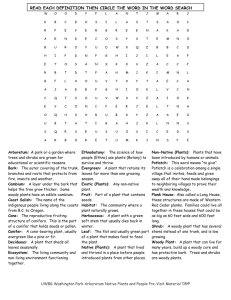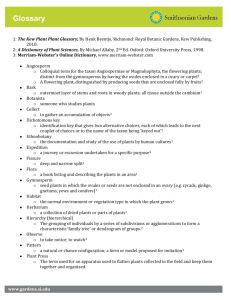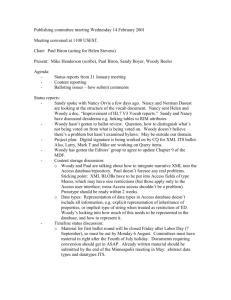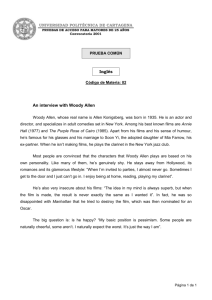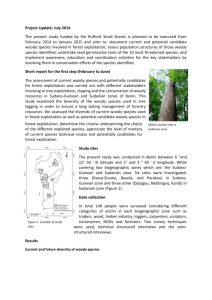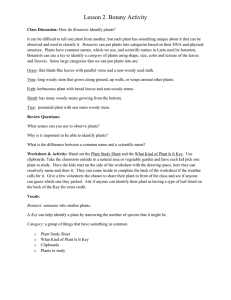Long-term Cross-scale Assessment of Woody Cover Stability in Drylands C. Huang
advertisement
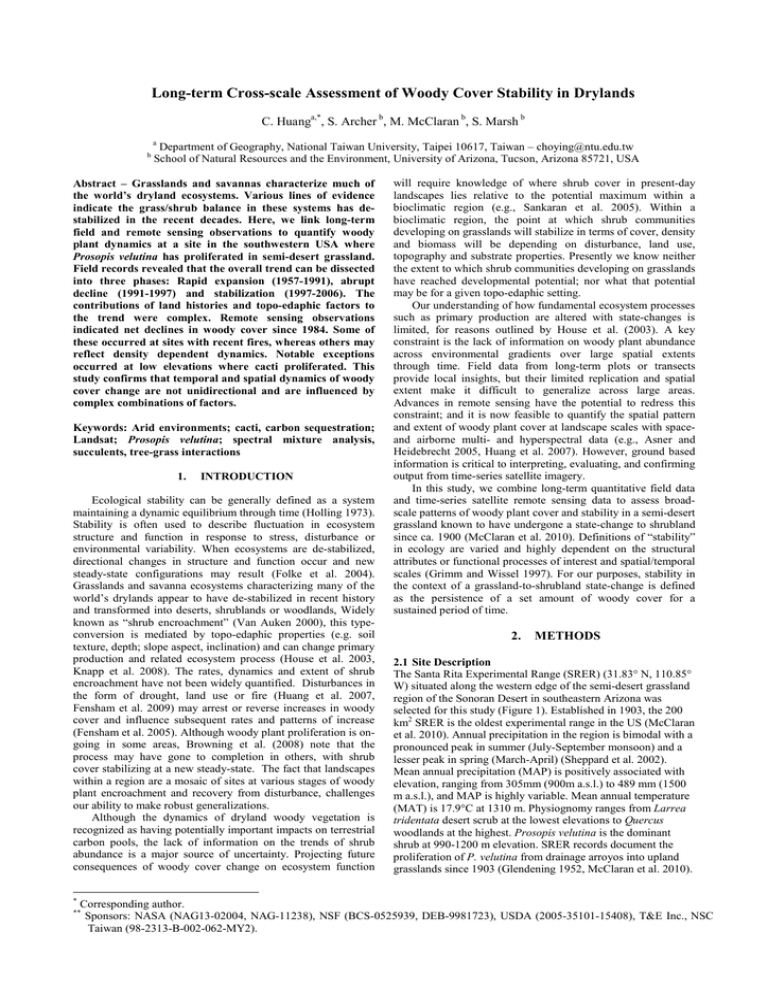
Long-term Cross-scale Assessment of Woody Cover Stability in Drylands C. Huanga,*, S. Archer b, M. McClaran b, S. Marsh b a b Department of Geography, National Taiwan University, Taipei 10617, Taiwan – choying@ntu.edu.tw School of Natural Resources and the Environment, University of Arizona, Tucson, Arizona 85721, USA Abstract – Grasslands and savannas characterize much of the world’s dryland ecosystems. Various lines of evidence indicate the grass/shrub balance in these systems has destabilized in the recent decades. Here, we link long-term field and remote sensing observations to quantify woody plant dynamics at a site in the southwestern USA where Prosopis velutina has proliferated in semi-desert grassland. Field records revealed that the overall trend can be dissected into three phases: Rapid expansion (1957-1991), abrupt decline (1991-1997) and stabilization (1997-2006). The contributions of land histories and topo-edaphic factors to the trend were complex. Remote sensing observations indicated net declines in woody cover since 1984. Some of these occurred at sites with recent fires, whereas others may reflect density dependent dynamics. Notable exceptions occurred at low elevations where cacti proliferated. This study confirms that temporal and spatial dynamics of woody cover change are not unidirectional and are influenced by complex combinations of factors. Keywords: Arid environments; cacti, carbon sequestration; Landsat; Prosopis velutina; spectral mixture analysis, succulents, tree-grass interactions 1. INTRODUCTION Ecological stability can be generally defined as a system maintaining a dynamic equilibrium through time (Holling 1973). Stability is often used to describe fluctuation in ecosystem structure and function in response to stress, disturbance or environmental variability. When ecosystems are de-stabilized, directional changes in structure and function occur and new steady-state configurations may result (Folke et al. 2004). Grasslands and savanna ecosystems characterizing many of the world’s drylands appear to have de-stabilized in recent history and transformed into deserts, shrublands or woodlands, Widely known as “shrub encroachment” (Van Auken 2000), this typeconversion is mediated by topo-edaphic properties (e.g. soil texture, depth; slope aspect, inclination) and can change primary production and related ecosystem process (House et al. 2003, Knapp et al. 2008). The rates, dynamics and extent of shrub encroachment have not been widely quantified. Disturbances in the form of drought, land use or fire (Huang et al. 2007, Fensham et al. 2009) may arrest or reverse increases in woody cover and influence subsequent rates and patterns of increase (Fensham et al. 2005). Although woody plant proliferation is ongoing in some areas, Browning et al. (2008) note that the process may have gone to completion in others, with shrub cover stabilizing at a new steady-state. The fact that landscapes within a region are a mosaic of sites at various stages of woody plant encroachment and recovery from disturbance, challenges our ability to make robust generalizations. Although the dynamics of dryland woody vegetation is recognized as having potentially important impacts on terrestrial carbon pools, the lack of information on the trends of shrub abundance is a major source of uncertainty. Projecting future consequences of woody cover change on ecosystem function * will require knowledge of where shrub cover in present-day landscapes lies relative to the potential maximum within a bioclimatic region (e.g., Sankaran et al. 2005). Within a bioclimatic region, the point at which shrub communities developing on grasslands will stabilize in terms of cover, density and biomass will be depending on disturbance, land use, topography and substrate properties. Presently we know neither the extent to which shrub communities developing on grasslands have reached developmental potential; nor what that potential may be for a given topo-edaphic setting. Our understanding of how fundamental ecosystem processes such as primary production are altered with state-changes is limited, for reasons outlined by House et al. (2003). A key constraint is the lack of information on woody plant abundance across environmental gradients over large spatial extents through time. Field data from long-term plots or transects provide local insights, but their limited replication and spatial extent make it difficult to generalize across large areas. Advances in remote sensing have the potential to redress this constraint; and it is now feasible to quantify the spatial pattern and extent of woody plant cover at landscape scales with spaceand airborne multi- and hyperspectral data (e.g., Asner and Heidebrecht 2005, Huang et al. 2007). However, ground based information is critical to interpreting, evaluating, and confirming output from time-series satellite imagery. In this study, we combine long-term quantitative field data and time-series satellite remote sensing data to assess broadscale patterns of woody plant cover and stability in a semi-desert grassland known to have undergone a state-change to shrubland since ca. 1900 (McClaran et al. 2010). Definitions of “stability” in ecology are varied and highly dependent on the structural attributes or functional processes of interest and spatial/temporal scales (Grimm and Wissel 1997). For our purposes, stability in the context of a grassland-to-shrubland state-change is defined as the persistence of a set amount of woody cover for a sustained period of time. 2. METHODS 2.1 Site Description The Santa Rita Experimental Range (SRER) (31.83° N, 110.85° W) situated along the western edge of the semi-desert grassland region of the Sonoran Desert in southeastern Arizona was selected for this study (Figure 1). Established in 1903, the 200 km2 SRER is the oldest experimental range in the US (McClaran et al. 2010). Annual precipitation in the region is bimodal with a pronounced peak in summer (July-September monsoon) and a lesser peak in spring (March-April) (Sheppard et al. 2002). Mean annual precipitation (MAP) is positively associated with elevation, ranging from 305mm (900m a.s.l.) to 489 mm (1500 m a.s.l.), and MAP is highly variable. Mean annual temperature (MAT) is 17.9°C at 1310 m. Physiognomy ranges from Larrea tridentata desert scrub at the lowest elevations to Quercus woodlands at the highest. Prosopis velutina is the dominant shrub at 990-1200 m elevation. SRER records document the proliferation of P. velutina from drainage arroyos into upland grasslands since 1903 (Glendening 1952, McClaran et al. 2010). Corresponding author. Sponsors: NASA (NAG13-02004, NAG-11238), NSF (BCS-0525939, DEB-9981723), USDA (2005-35101-15408), T&E Inc., NSC Taiwan (98-2313-B-002-062-MY2). ** Fire is the most destructive disturbance in drylands. There were two major fire events occurred in SRER in the past two decades (Huang et al. 2007) (Figure 1a). Studies assessing the impacts of one event on P. velutina revealed that approximately 90% of the plants were severely impacted (Gottfried et al. 2003). SRER was subjected to managed yearlong (YL) grazing since 1915 until 1957 when several rest strategies were applied (Ruyle 2003). A grazing system, known as the Santa Rita Grazing System (RG), has been continuously implemented since 1972 (Figure 1a). The schedules of grazing and rest for a set of three pastures was based upon three seasons (NovemberFebruary, March-June, July-October); and each pasture is grazed for 1-2 consecutive seasons following by a full year of rest (Martin 1978). Martin and Severson (1988) indicated that RG may enhance recovery of pastures in poor condition. Since 1972, YL and RG have been consistently applied in one (1855 ha) and four (3988 ha) designated pastures. Because of the contrasting fire regimes and grazing rotations, large sizes, the availability of detailed information of topography and geomorphic landforms, and close proximity with similar climatic conditions (Figure 1), these settings afforded unique opportunities to study the effects of anthropogenic perturbations and physical environments on woody plant stability at a large scale. Figure. 1 (a) Locations of pastures in different grazing rotations (YL vs. RG) since 1972 and areas with recent fire history (light colored pixels) in SRER. The irregular dashed lines and triangles are elevation contour lines and rain stations, respectively. (b) The location of SRER and major cities within Arizona. (c) The landform pattern of SRER. 2.2 Long-term Field Records There were 132 - 30.5 m (100 ft) permanent line transects installed at the SRER between 1953 and 1975, and these represent a wide range of topo-edaphic settings. Measures of projected woody canopy (entire live crown intercept excluding conspicuous openings or areas of dead crown for P. velutina and other shrubs, sub-shrubs and cacti) and basal herbaceous cover have been made at 1 to 7 y intervals through 2006. In this study, we only used the information of projected woody canopy cover (hereafter “woody cover”), which was recorded as the entire live crown intercept excluding conspicuous openings or areas of dead crown. In order to match remotely sensed data collection period, only transects with measures continuously made since 1984 were selected (n = 81) for analysis. Note that no transect had experienced recent fire disturbance. Long-term MAP records for summer (April-September) and winter (from previous October to current March) from 75 gauges (Figure 1a) widely spreading at SRER were also obtained from the SRER website1; MAT data for summer and winter were acquired from six meteorological stations nearby SRER from the National Climate Data Center2. The data collection of MAP and MAT initiated as early as 1922 and 1956, respectively. However, we only used records from 1957 to 2006 in corresponding with the field woody cover measurement period. Deviations ∆MAP and ∆MAT, which are the differences to the mean MAP and MAT from 1957-2006, for observing regional climatic trends were also computed for summer and winter seasons for each year. 2.3 Remote Sensing Eighteen sets of pre-summer (May, June) Landsat Thematic Mapper (TM) and Enhanced Thematic Mapper plus (ETM+) images with minimum cloud contamination and spanning the 1984 and 2005 time-period were utilized. In southern Arizona, semi-arid environments generally exhibit the least amount of herbaceous green biomass during this time period; green vegetation signals derived from satellite data are almost exclusively from woody plants. Landsat TM and ETM+ are multi-spectral sensors that contain six 30m visible, near infrared (NIR) and shortwave infrared (SWIR) bands, and one thermal band. The historical data was available for the TM sensor beginning in 1984; and for the ETM+ sensor from 1999 onward. Both sensors are still active. Image pre-processing entailed radiometric calibration, including geometric rectification and the removal of atmospheric effects. All images were ortho-rectified based upon a pre-registered Landsat image and a Digital Elevation Model (DEM). The root mean square error of ortho-rectification was controlled to less than half of a pixel (< 15 m) for each image. In addition, a second-degree polynomial geometric model and nearest-neighbor re-sampling were applied during orthorectification to minimize distortion of spectral properties during image registration. Atmospheric correction utilized the cosine of the solar zenith angle correction (COST) model (Chavez 1996). The absolute surface reflectance of an invariant target will differ even with identical atmospheric and illumination conditions due to sensor degradation (Schott et al. 1988, Hall et al. 1991). The impact of sensor degradation is not pronounced if the time between scenes is short. However, the time extent of this study was more than two decades, and we used a Landsat image acquired on year 2000 as the reference image and calibrated other images to this one. 2.4 Woody Cover Abundance and Dynamics We used a probabilistic spectral mixture analysis approach (Asner and Lobell 2000) to unmix fractional woody vegetation cover from long-term pre-monsoon Landsat images. Specific settings of for this study have been described in Huang et al. (2007). After deriving the long-term fractional woody vegetation cover, we calibrated it to field measured woody cover by referring to Huang et al. (2007). For each pixel, we computed the mean and coefficient of variation CV (%) [(standard deviation (sd)/mean) × 100] through time. Additionally, we applied a trend analysis on each pixel to compute the rate of woody change per year using woody cover and year as the dependent and independent variables, respectively. In order to reduce the signals of noisy pixels, a correction procedure was applied on the trend map by multiplying (1-uncertainty), where uncertainty is inversely related to the fitness (r2) of a trend line to each pixel. 2.5 Physical Environments /Anthropogenic Perturbations 1 2 http://www.ag.arizona.edu/srer/ http://www.ncdc.noaa.gov/oa/ncdc.html Elevation was obtained from a US Geological Survey DEM 3. Physiographic patterns (e.g., slope inclination and aspect) were homogeneous and excluded from the analysis. The spatial layer of geomorphic landforms was obtained from the SRER website (Figure 1c). The substrate data were originally in a vector format, and we converted them to 30 m grids using a Geographic Information System to match the Landsat images.The spatial layers of fire histories and pastures under YL and RG were acquired from Huang et al. (2007) and the SRER website, respectively. cactus (mainly Opuntia engelmannii) populations according to the field validation (Figure 4). 2.6 Woody Cover Stability Owing to the large number of data points generated by the satellite imageries (n ≈ 264,000 for the entire SRER) and most of these data were spatially correlated, we randomly selected 400 pixels from a large data pool to control the uncertainty < 5% (Yamane 1967); the random procedure should minimize spatial autocorrelation resulting biases and justify the use of a standard statistical analysis (Brus and DeGruijter 1993). 3. RESULTS 3.1 Field Woody Cover and Climate Trends Increase of woody cover was tardy (0.1% yr-1) by solely comparing the starting (1957) and end (2006) years of the field observation period (Figure 2a). However, the trend can be dissected into three periods: Fast growth (1957-1991, 0.6% yr-1), abrupt decline (1991-1997, 2.3% yr-1) and stabilization (19972006). In addition, variation (standard error, se) was quite similar through years (mean se = 1.7% ranging 1.2-2.4%). Mean summer and winter MAPs from 1957 to 2006 were 230.7 mm and 153.3 mm, respectively; MATs were 22.2°C and 11.2°C, respectively, respectively (Figure 2b and 2c). There were 10 out of 14 summer ∆MAPs and 9 out of 11 winter ∆MAPs below the long-term averages in the recent years; the increases of ∆MATs were pronounced in both summer and winter especially after 1995. 3.2 Regional Analysis of Woody Cover Dynamics Regional estimates of recent (1984-2005) mean woody cover (± sd) and CV (± sd) of SRER derived from dry season Landsat images were 26.5 ± 3.4 % and 11.7 ± 1.2 %, respectively. Overall, woody cover at SRER decreased (mean trend ± sd = 0.8 ± 0.7 % yr-1); the mean tendency (decrease) did not change after taking the model significance into account (Figure 3). 3.3 Topo-edaphic factors There was a significant (r2 = 0.28, p < 0.01) positive linear relationship between elevation and remote sensing estimated mean woody cover; a weak but significant (r2 = 0.06, p < 0.01 for the intercept and coefficients) quadratic relationship was found between elevation and woody CV. However, elevation failed to explain the variations of mean woody cover and CV based upon field observations. The majority of surface soils in SRER had high proportions of sand (≥ 66%), medium silt (1923%) and low clay (10-11%) contents, respectively. We found that in terms of model fitness, these soil texture attributes did not delineate the variations of mean woody cover and CV regardless of field or remote sensing estimates (r2 ≤ 0.03). According to remote sensing observations, the areas with positive trends (woody cover increase) were mainly located at lower elevation approximately from 910-1050 m. The increase of woody cover in low elevation can be related to the growth of 3 http://seamless.usgs.gov/ Figure 2. (a) Long-term (1957-2006) trends of field measured woody cover in SRER with error bars indicating one standard error from the mean. Deviations of (b) summer (AprilSeptember) and (c) winter (from previous October to current March) ∆MAP and ∆MAT relative to the MAP and MAT are shown as bars and dashed lines, respectively. Figure. 3. A color woody variation map using long-term (19842005) mean woody cover for the green channel, woody CV for the blue channel and adjusted woody trend for the red channel. The color indices for extreme cases are listed below the figure. Cover CV Trend Cover CV Trend High High + Low High + High High – Low High – High Low + Low Low + High Low – Low Low – 3.4 Wildfire and managed grazing The elevation range (mean ± sd) of areas with recent fire histories (1169.9 ± 64.3 m) was slightly higher than the rest of the range unburned areas (1066.0 ± 128.9 m). However, there was no difference in remote sensing woody cover for these two groups (one-way ANOVA, p = 0.31). In contrast, high woody CV of burned area can be clearly differentiated from unburned area (burned = 36.9 ± 0.5%, unburned = 28.6 ± 0.1%). Areas with recent fire histories (Figure 1a), and a medium-sized patch located at the east side of the low altitude woody cover increase area can be clearly discerned in the adjusted trend map (Figure 3). The mean elevation of YL pastures (1001.8 ± 95.2 m) was similar to those under RG management (1085.8 ± 108.1 m); there was no difference (p ≥ 0.66) of mean woody cover observed from field and remote sensing. The woody CV difference of these two types of pastures was discernible in remote sensing (p < 0.01) but not from field data (p = 0.72). No clear trend of woody abundance among different grazing management types (YL, RG, Mixed 4 ) from both field and remote sensing observations (data not shown). Figure. 4. A typical Opuntia engelmannii community in the northern SRER (Photo credit: M. McClaran). 4. • • • CONCLUSIONS Ground-based transect data revealed that the overall timeseries of woody cover change was not uniform. Rather, it exhibited three distinct phases: Rapid expansion, abrupt decline and stabilization. Interactions among physical environments, fire and livestock grazing were complex and difficult to decipher. Remote sensing observations indicated net declines in woody cover especially at sites with recent fires. Notable exceptions occurred at low elevations where cacti proliferated. This study confirms that temporal and spatial dynamics of woody cover change are not uni-directional and are influenced by complex combinations of drivers. REFERENCES Asner, G.P., and K.B. Heidebrecht. 2005. Desertification alters regional ecosystem-climate interactions. Global Change Biology 11:182-194. Asner, G.P., and D.B. Lobell. 2000. A biogeophysical approach for automated SWIR unmixing of soils and vegetation. Remote Sensing of Environment 74:99-112. Breshears, D.D., et al. 2005. Regional vegetation die-off in response to global-change-type drought. Proceedings of the National Academy of Sciences USA 102:15144 -15148. Browning, D.M., S.R. Archer, G.P. Asner, M.P. McClaran, and C.A. Wessman. 2008. Woody plants in grasslands: Postencroachment stand dynamics. Ecological Applications 18:928-944. Brus, D.J., and J.J. DeGruijter. 1993. Design-based versus model-based estimates of spatial means: Theory and application in environmental soil science. Environmetrics 4:123-152. Chavez, P.S., Jr. 1996. Image-based atmospheric correctionsrevisited and improved. Photogrammetric Engineering & Remote Sensing 62:1025-1036. Fensham, R.J., Fairfax, R.J., and Archer, S. 2005. Rainfall, land use and woody vegetation cover change in semi-arid Australian savanna. Journal of Ecology 93:596-606. Fensham, R., R. Fairfax, and D. Ward. 2009. Drought-induced tree death in savanna. Global Change Biology 15:380-387. Folke, C., et al. 2004. Regime shifts, resilience, and biodiversity in ecosystem management. Annual Review of Ecology Evolution and Systematics 35:557. 4 Pastures subjected to the rotation of YL and RG. Glendening, G.E. 1952. Some quantitative data on the increase of mesquite and cactus on a desert grassland range in Southern Arizona. Ecology 33:319-328. Gottfried, G.J., P.F. Ffolliott, P. Garcia, D. Valdez-Zamudio, and A. Al-Khouri. 2003. Assessment of fire-damaged mesquite trees 8 years following an illegal burn. In: Santa Rita Experimental Range: 100 years (1903-2003) of accomplishments and contributions. Rocky Mountain Research Station, CO. p. 166-168. Grimm, V., and C. Wissel. 1997. Babel, or the ecological stability discussions: an inventory and analysis of terminology and a guide for avoiding confusion. Oecologia 109:323-334. Hall, F.G., D.E. Strebel, J.E. Nickeson, and S.J. Goetz. 1991. Radiometric rectification: Toward a common radiometric response among multidate, multisensor images. Remote Sensing of Environment 35:11-27. Holling, C.S. 1973. Resilience and stability of ecological systems. Annual Review of Ecology and Systematics 4:1-23. Houghton, R.A. 2003. Revised estimates of the annual net flux of carbon to the atmosphere from changes in land use and land management 1850-2000. Tellus 55B:378-390. House, J.I., S. Archer, D.D. Breshears, and R.J. Scholes. 2003. Conundrums in mixed woody-herbaceous plant systems. Journal of Biogeography 30:1763-1777. Huang, C., S. Marsh, M. McClaran, and S. Archer. 2007. Postfire stand structure in a semi-arid savanna: Cross-scale challenges estimating biomass. Ecological Applications 17:1899-1910. Knapp, A.K., et al. 2008. Shrub encroachment in North American grasslands: Shifts in growth form dominance rapidly alters control of ecosystem carbon inputs. Global Change Biology 14:615-623. Martin, C.S., and K.E. Severson. 1988. Vegetation response to the Santa Rita grazing system. Journal of Range Management 41:291-295. Martin, S.C. 1978. The Santa Rita grazing system. Pages 573575 in First International Rangelands Congress: Proceedings. Society for Range Management, Denver, CO. McClaran, M., Browning, D., and Huang C. 2010. Temporal dynamics and spatial variability in desert grassland vegetation. In Repeat Photography: Methods and Applications in the Natural Sciences. Webb RH, Boyer DE, Turner RM (Eds), pp. 145-166. Island Press, Washington, DC, USA. Ruyle, G.B. 2003. Rangeland livestock production: Developing the concept of sustainability on the Santa Rita Experimental Range. In: Santa Rita Experimental Range: 100 years (19032003) of accomplishments and contributions. Rocky Mountain Research Station, CO. p. 34-47. Schimel, D.S., et al. 2001. Recent patterns and mechanisms of carbon exchange by terrestrial ecosystems. Nature 414:169172. Schott, J.R., C. Salvaggio, and W.J. Volchok. 1988. Radiometric scene normalization using pseudoinvariant features. Remote Sensing of Environment 26:1-14. Sankaran, M., et al.. 2005. Determinants of woody cover in African savannas. Nature 438:846-849. Sheppard, P.R., M.K. Hughes, A.C. Comrie, G.D. Packin, and K. Angersbach. 2002. The climate of the US Southwest. Climate Research 21:219-238. Van Auken, O.W. 2000. Shrub invasions of North American semiarid grasslands. Annaul Review of Ecology and Systematics 31:197-215. Yamane, T. 1967. Statistics: An introductory analysis. 2nd edition. Harper and Row, New York.
